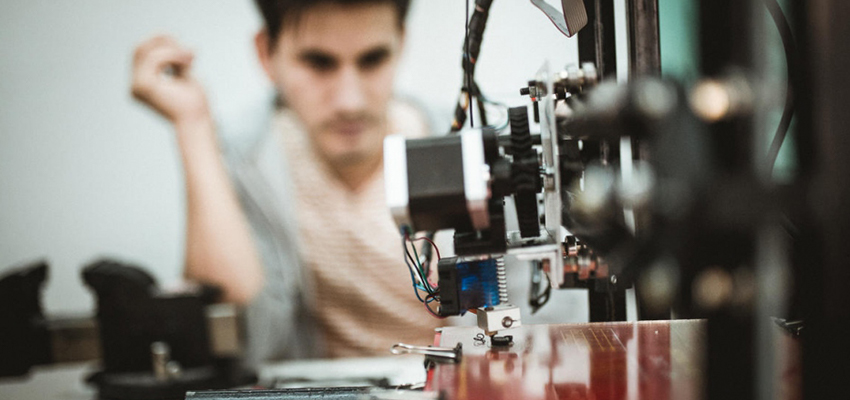
Teenaged asylum-seekers in Athens are hooked on classes that show them how to use technology to express their creativity.
Original article as posted by UNHCR
Syrian teenager Odai* holds up a pair of spectacles held together by sticky tape. They belong to his friend Farshid*, who is leaving Athens in a few days to reunite with his family in Austria.
“My teachers said maybe I can help fix them,” the 14-year-old tells UNHCR.
He says he will try to make a new arm for his compatriot’s glasses on a machine he has helped to build. This is no ordinary contraption and his teachers include highly skilled technicians working at one of the world’s leading universities, the Massachusetts Institute of Technology (MIT) in the United States.
Behind Odai, on a table full of laptops, others are completing work on the device, made up of electronics components, plastic filament, a ceramic platform and a metal frame. Moments later the machine, a 3D printer, comes to life and starts to create its first three-dimensional object, a disc with logo.
It is quite an achievement for children who knew almost nothing about electronics, computers or design before attending the Digital Design Fabrication Workshop, but even more remarkable is how this two-week project backed by UNHCR, the UN Refugee Agency, galvanized and transformed those taking part.
More than 20 asylum-seeker children from Syria, Afghanistan, Iraq and Pakistan, aged from nine to 17, took part in the intensive course, organized by the MIT D-Lab and a local NGO, Faros, a UNHCR partner. It included vulnerable unaccompanied children such as Odai and Farshid.
“You can see how creative they are.”
Dan Biswas, co-founder of Faros, says most had been starved of an education because of conflict and, after a slow start, they were hooked by the classes and the idea of creating something that they could be proud of. Most attended every session, morning and afternoon, hungry for knowledge. Lunch was an interruption.
“With a little bit of push and nurturing, we see that they can really flourish and recognize their own worth and potential,” says Biswas, who hosted the training in a spacious renovated building in the run-down Exarcheia district, a hive of creativity. Faros also runs a shelter for unaccompanied children nearby, where many of those taking part lived. Others came from accommodation sites.
“Hopefully they will continue these programmes. You can see how creative they are,” says Heewon Lee, a designer at MIT D-Lab. The course also taught basic computer skills, programming and software as well as how to use hand tools such as soldering irons, screwdrivers, wire cutters and files. “They made something cool.”
Roy Ombatti, trainer and founder of African Born 3D, an affiliate of the D-Lab, was also impressed. “It’s a mindset change for them. It’s very empowering. We broke down something that seems so complex.”
The boys taking part built friendships with the tutors as well as with their fellow students, despite different origins and languages. “They opened up and were telling us about their stories,” Heewon says. “They didn’t want to go home at the end of the day.”
“It’s a very good feeling, and you share this with your friends.”
The project is based on a three-step approach – bring them in, keep them in (with projects like the 3D printer) and, eventually, send them out … to school, internships, employment and the like. Using this formula, Faros also runs popular carpentry and tailoring courses.
The 3D printer is a manufacturing tool that can be used to create anything, according to the tutors. For boys who have lost so much, it is a topic of endless discussion. A few days earlier, they had never heard of such a machine, which takes a design created on a computer then, using plastic or organic material, builds layers to create an object.
The applications are as wide as the imagination and the technology is being used in areas ranging from manufacturing, health care and chemistry to architecture, art and design. Some companies even use 3D printers to create more 3D printers.
Odai, who fled violence in Damascus , feels much more confident after this experience. “It’s a very good feeling, and you share this with your friends,” says the teenager.
In the end, Odai did not have enough time to make an arm for Farshid’s glasses, but he had made friends and acquired a thirst for knowledge that could help him in the future. His ambitions have also grown. “Maybe I can become a teacher and build something much bigger,” he says.
* Names have been changed for protection reasons.
Read original story and see slideshow of images on UNHCR website.
More information
MIT D-Lab Humanitarian Innovation Program
Creative Capacity Building with Unaccompanied Refugee Minors - Athens, Greece
Contact
Amy Smith, Founding Director, MIT D-Lab
Martha Thompson, Humanitarian Innovation Specialist, Instructor

